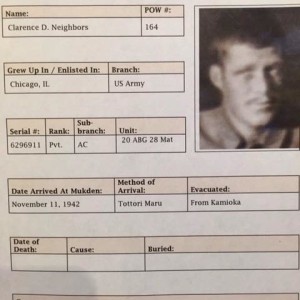Texas woman wins contest with essay on father’s Bataan POW ordeal

Clarence Neighbors was shot down over the Philippines in April 1942, endured the Bataan Death March and life as a POW in Japan. He died in 1983. FACEBOOK
SAN FRANCISCO – A resident of El Paso, Texas won an essay contest by tracing her late father’s horrific experience in the Bataan Death March during World War II and as a prisoner of war in both the Philippines and Japan.
Managers from the US Army & Air Force Exchange at Fort Bliss awarded Linda Anderson a $1,000 Exchange gift card last December as prize for her winning essay in the Army & Air Force Exchange Service’s worldwide “Who’s My Superhero and Why” essay contest.
Anderson’s essay traced her father’s journey from being shot down in a B-17 over the Philippines in April 1942 to being liberated from the lead mines in Kamioka, Japan, at the war’s end in August 1945.
Her father, Pvt. Clarence Neighbors, was one of the 75,000 American and Filipino prisoners of war who made the excruciating—and for many, deadly—65-mile march to Japanese POW camps in the Philippines during World War II.
After the Death March, Neighbors was put on the hell ship Tottori Maru and taken to Korea, where he was transferred to an old Mitsubishi factory in Manchuria, China.
He and the other prisoners were forced to make tank and airplane parts. Anderson’s father was one of 150 men transferred to Kamioka after they were caught sabotaging the factory. The six-foot-three. Neighbors weighed 89 pounds upon his release, according to the Belleville News Democrat.
Neighbors died in 1983 because of ongoing complications from tropical diseases and frostbite he contracted in the camps.
Though Anderson had known her father was in the Death March since she was 16, he never said much about his time as a POW. He could speak some Japanese and his prisoner number was 164.
Anderson remembers the personality quirks she attributed to his time in the camps, such as checking refrigerators and cabinets for food whenever he would visit the homes of friends and family, and he ate “almost like he was in a trance.”
Anderson continuously champions the Death Marchers’ story. She several reunions for survivors and descendants held annually in various locations across the country; in 2010 she attended the Bataan Memorial Death March at White Sands Missile Range.

